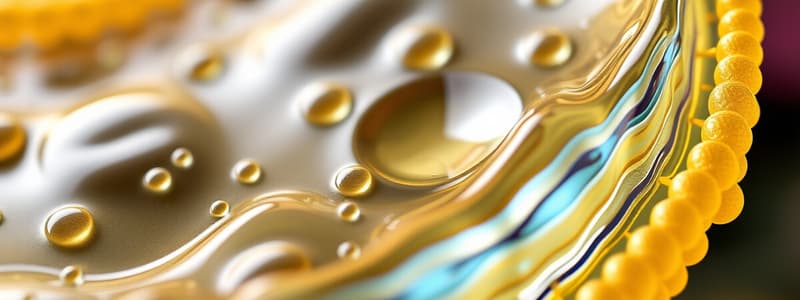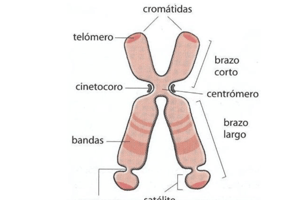Podcast
Questions and Answers
What is the term for the movement of lipid molecules from one half of the bilayer to the other?
What is the term for the movement of lipid molecules from one half of the bilayer to the other?
- Lateral diffusion
- Intra-chain motion
- Axial rotation
- Flip-flop (correct)
Which mode of lipid mobility involves movement within the same plane of the bilayer?
Which mode of lipid mobility involves movement within the same plane of the bilayer?
- Intra-chain motion
- Fast lateral diffusion (correct)
- Fast axial rotation
- Flip-flop
Which of the following describes the formation of kinks in the fatty acyl chains of lipids?
Which of the following describes the formation of kinks in the fatty acyl chains of lipids?
- Intra-chain motion (correct)
- Flip-flop
- Axial rotation
- Lateral diffusion
What is the capability of lipid molecules to rotate along their axes called?
What is the capability of lipid molecules to rotate along their axes called?
Which of the following is NOT a mode of mobility for lipid molecules in a bilayer?
Which of the following is NOT a mode of mobility for lipid molecules in a bilayer?
The fluid nature of membranes allows for which of the following lipid mobility modes?
The fluid nature of membranes allows for which of the following lipid mobility modes?
What effect do unsaturated double bonds in fatty acids have on membrane fluidity?
What effect do unsaturated double bonds in fatty acids have on membrane fluidity?
What is the approximate protein content in myelin?
What is the approximate protein content in myelin?
Which mode of protein motion within the bilayer is prohibited?
Which mode of protein motion within the bilayer is prohibited?
What function do membrane proteins NOT perform?
What function do membrane proteins NOT perform?
What is the typical percentage of protein in the dry weight of membranes?
What is the typical percentage of protein in the dry weight of membranes?
What factor does NOT restrict the mobility of membrane proteins?
What factor does NOT restrict the mobility of membrane proteins?
In which cellular structure can protein content be as high as 75%?
In which cellular structure can protein content be as high as 75%?
What is a consequence of cholesterol-poor regions within membranes?
What is a consequence of cholesterol-poor regions within membranes?
What is a primary function of biological membranes?
What is a primary function of biological membranes?
What approximate percentage of a biological membrane is made up of lipids?
What approximate percentage of a biological membrane is made up of lipids?
Which class of membrane lipids contains both hydrophilic and hydrophobic parts?
Which class of membrane lipids contains both hydrophilic and hydrophobic parts?
Which of the following is NOT a major class of membrane lipids?
Which of the following is NOT a major class of membrane lipids?
What is the primary role of carbohydrates in membranes?
What is the primary role of carbohydrates in membranes?
What percentage of total membrane lipid is cholesterol?
What percentage of total membrane lipid is cholesterol?
How does cholesterol stabilize the plasma membrane?
How does cholesterol stabilize the plasma membrane?
What effect does cholesterol have on phospholipid packing?
What effect does cholesterol have on phospholipid packing?
What is the main driving force for bilayer formation in water?
What is the main driving force for bilayer formation in water?
What do pure lipid bilayers generally exhibit regarding permeability?
What do pure lipid bilayers generally exhibit regarding permeability?
Which statement about cholesterol's effect on membrane fluidity is correct?
Which statement about cholesterol's effect on membrane fluidity is correct?
In what type of structure do amphipathic molecules typically form in water?
In what type of structure do amphipathic molecules typically form in water?
What stabilizes the cooperative structure of lipid bilayers?
What stabilizes the cooperative structure of lipid bilayers?
Which of the following is true about tissue-specific lipid distribution?
Which of the following is true about tissue-specific lipid distribution?
What happens to the endothermic phase transition of phospholipid bilayers with cholesterol?
What happens to the endothermic phase transition of phospholipid bilayers with cholesterol?
Flashcards are hidden until you start studying
Study Notes
Dynamics in Lipid Bilayers
- Membrane structures are fluid, allowing lipid molecules to move within and between layers.
- Four modes of lipid mobility in bilayers:
- Fast lateral diffusion within the plane
- Flip-flop exchange of lipids between bilayer halves
- Intra-chain motion, allowing for kink formation in fatty acyl chains
- Fast axial rotation of lipid molecules
Importance of Unsaturated Fatty Acids and Cholesterol
- Unsaturated fatty acids disrupt hexagonal packing of phospholipids, enhancing membrane fluidity.
Membrane Proteins
- Membrane proteins perform essential functions including:
- Enzymatic activity, transport, pumping, ion channeling, signal reception, and energy transduction.
- Protein content varies significantly by membrane type, ranging from 18% in myelin to 75% in mitochondria.
- On average, proteins constitute about 60% of the dry weight of membranes.
Mobility of Proteins in Bilayers
- Three modes of protein motion:
- Conformational changes
- Rotational movement
- Lateral diffusion
- No flip-flop possible for large, hydrophilic proteins which require substantial energy to traverse the hydrophobic core.
Restrictions on Protein Mobility
- Mobility constraints arise from:
- Lipid-mediated effects causing segregation into fluid phases or cholesterol-deficient regions.
- Associations between membrane proteins.
- Linkages with peripheral proteins such as cytoskeletal components.
Cholesterol
- Constitutes about 45% of total membrane lipid and is crucial for plasma membrane stability.
- Cholesterol enhances membrane stability through hydrogen bonding with fatty acid chains, preventing phase transition.
- It reduces the packing of phospholipids, increasing fluidity but can also limit overall chain motion.
Lipid Bilayer Structure
- Formed by amphipathic molecules, leading to spontaneous bilayer formation in aqueous environments.
- Stabilized by non-covalent interactions like electrostatic and hydrogen bonds, along with hydrophilic interactions with water.
- Pure lipid bilayers exhibit low permeability to ions and polar molecules.
General Functions of Biological Membranes
- Serve as selective permeability barriers regulating chemical environments.
- Facilitate communication between cells and surrounding environments.
- Enable recognition through signaling molecules and adhesion proteins.
- Generate signals in response to quality stimuli, including electrical and chemical signals.
Membrane Composition
- Typical composition includes approximately:
- 40% lipids
- 60% proteins
- 1-10% carbohydrates
- 20% water content, indicating hydration.
Membrane Lipids
- Comprised of amphipathic molecules with both hydrophilic and hydrophobic components. Major classes include:
- Phospholipids
- Glycolipids
- Cholesterol
Phospholipids
- Predominant lipids in membranes, such as phosphatidylcholine.
- Feature diverse polar head groups including choline, amines, amino acids, and sugars.
- Fatty acid chains largely consist of C16 and C18, with unsaturated side chains reducing packing efficiency.
Plasmalogens
- A specific subclass of phospholipids present in nervous, immune, and cardiovascular tissues.
Glycolipids
- Carbohydrate-containing lipids with hydrophobic tails embedding them into membrane bilayers.
- Types include:
- Cerebrosides, containing single sugar monomer head groups.
- Gangliosides, which possess head groups with multiple sugar units.
Studying That Suits You
Use AI to generate personalized quizzes and flashcards to suit your learning preferences.



